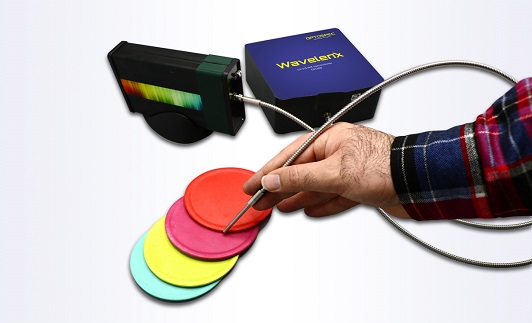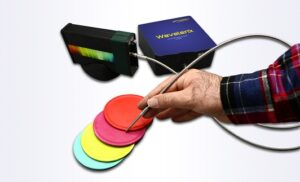Introduction
A spectrometer measures the interaction of light and matter, including the intensity and wavelength of light. A spectrometer is a device that measures optical properties in a specific region of the electromagnetic spectrum. This device is commonly used for analyzing materials. The results obtained from spectrophotometry display intensity as a function of wavelength on the screen.
A spectrometer is composed of various components, each of which plays a significant role in spectral analysis. In the following, we have examined these elements.
Components of Spectrometer
Optical spectroscopy is composed of four main components, which we briefly describe below. However, we have explained this section in detail in the article “Principles of Spectrometer Operation.” These elements are:
Slit: The function of the slit in a spectrometer is highly crucial. This element controls the amount of light (photon flux) that enters the spectrometer. Additionally, the slit is one of the influencing factors on spectral resolution. For this reason, the size of the slit needs to be optimized. Typically, the slit size in spectrometers is 10, 25, 50, 100, or 200 micrometers.
Scattering Element: The scattering element in a spectrometer defines the wavelength range and disperses light into its constituent wavelengths. Similar to the slit, this element also affects spectral resolution. In the past, prisms were used to build spectrometers. The scattering angles in prisms are temperature-sensitive, as the refractive index changes with temperature. Scattering angles also depend on the refractive index, causing them to change. That’s why holographic gratings are used instead of prisms in modern spectrometers.
Optical Elements: Optical elements like lenses and mirrors are used in spectrometers to direct and focus light.
Detector: A detector is a device that absorbs optical energy and converts it into electrical energy. Modern spectrometers commonly use CCD detectors. CCDs are made of silicon and are well-suited for measuring low-intensity light.
Up to this point in the article, you have become familiar with the main components of optical spectrophotometers. In the next stage, we will refer to the working principles of the spectrometer, which have been explained in detail.
Working Principle of Spectrometer
Spectrometer is a device that allows us to determine certain properties of a substance by having light interact with it. Light interacts with the substance, and the light resulting from the interaction is directed into the spectrometer through a slit. Then, this light is focused onto a holographic grating by a concave mirror. The holographic grating disperses the light into different wavelengths. In the next step, the scattered light is directed towards the detector by the second concave mirror. The detector converts this light into electrical signals through a process. Finally, the obtained data is displayed as a spectral graph on the screen. A spectrophotometer can be used to obtain absorbance, transmittance, reflectance, and fluorescence spectra. Additionally, it can analyze various light sources. One of the main applications of a spectrometer is to determine the emission spectra of light sources, such as lasers, by measuring their wavelengths.

Up to this point in the article, you have become familiar with the basics of a spectrometer. Now, we want to delve into how it works, its maintenance, and calibration.
How to Use a Spectrometer
The types of spectrometers vary depending on their application. These models include general-purpose spectrometers, cooled spectrometers, triggered spectrometers, and high-resolution spectrometers, each with unique features and applications. Texas Instruments, drawing on the experience and knowledge of its experts, manufactures 16 different models of spectrometers tailored to your needs, which you can view.

It’s worth noting that operating these devices is quite simple
To operate Wavelenx spectrometers, you simply need to follow these steps:
Before doing anything, first determine the type of experiment (reflectance, transmittance, absorbance, or fluorescence). Our goal in this section is to familiarize you with how a spectrometer works. For this reason, we will explain how to operate this device through the absorbance experiment, as depicted in Figure 3. Of course, the arrangement for transmittance, reflectance, fluorescence, and emission spectroscopy is fully explained in the spectrometry article.

- In the second step, connect the spectrometer to your computer via a USB cable. Wavelenx spectrometers do not require a separate power cable as they draw power from the computer.
- Next, turn on the light source and launch the software.
- Apply the spectroscopy settings.
- By clicking on the spectroscopy option, you can obtain the absorption spectrum of the desired sample.
After completing your work, pay attention to the proper maintenance of this device. We will continue to discuss some points that will assist you in maintaining the spectrometer correctly.
Maintenance Conditions
- The spectrometer contains sensitive optical and electronic components. Avoid applying excessive pressure to the device’s body and fiber connector separately.
- Avoid subjecting it to mechanical and electrical shocks.
- Never open the spectrometer as it may displace optical components during the process. It’s possible for dust to settle on these components, resulting in improper functionality. In this case, the device’s warranty and after-sales service may be voided (in which case Optospect Corporation will not be liable for any subsequent issues or damages).
- Place the spectrometer only on the designated surface. Avoid positioning it face-down or in any other way, as it may affect the device’s calibration.
Calibration ensures that the results obtained are accurate. That’s why we’ve dedicated the next section to this topic.
Spectrometer Calibration
Calibration is crucial for obtaining accurate and precise results. As mentioned earlier, spectrometers are used to determine the wavelengths of light sources, making calibration essential. Typically, calibration is performed using calibration lamps. These lamps have very good emission spectra at specific wavelengths. This feature allows experts to calibrate and adjust their systems using these wavelengths. In this method, the emission spectra of light sources are obtained using a spectrometer. The positions of the lamp’s wavelengths in the emission spectrum are constant. Calibration means assigning specific wavelengths to each of the detector’s pixels. To achieve this, mercury-argon (Hg-Ar) lamps are commonly used. Figure 4 shows the emission spectrum of an Hg-Ar lamp. This spectrum was obtained by the Optospect spectrometer, Wavelenx. It is important to note that the obtained spectrum perfectly matches the standard spectrum of a mercury-argon lamp.

As evident from Figure 4, emission lines are not observed in a range of wavelengths. To calibrate these wavelengths, an interpolation method is used.
Calibrating the spectrometer is essential to ensure accurate results as long as it is used properly. Therefore, remember to follow the maintenance guidelines for the device to avoid any issues. Optospect spectrometers do not require calibration each time you use them. These devices are calibrated and set by experienced professionals before they are made available to you. If you ever feel that the device’s settings have become disorganized, please contact us. We will promptly resolve your issues.
Summary
A typical application of a spectrophotometer is to measure the wavelengths of electromagnetic radiation (light). Using this device, you can obtain emission, absorption, transmission, reflection, and fluorescence spectra. A spectrometer is composed of four main elements, each of which plays a crucial role in its operation.
As mentioned, a spectrophotometer is used for the analysis of light. Its operation involves the initial entry of light through a slit, followed by guiding it towards a diffraction grating with a concave mirror. The diffraction grating disperses the light into various wavelengths. The scattered light is then focused onto a detector using lenses and mirrors. This process results in obtaining the desired spectrum.
A spectrophotometer contains delicate optical components, so it’s essential to handle it with care during maintenance. In this article, we’ve provided guidelines for proper maintenance to extend the device’s lifespan and ensure its calibration remains accurate. Calibration of the spectrophotometer is a critical parameter, as incorrect settings can lead to inaccurate results. Therefore, the spectrophotometer is calibrated using calibration lamps before it is made available for your use.
Up to this point, we’ve provided a general overview of the spectrophotometer. To gain a deeper understanding of this device, we’ve prepared a video that can help you further enhance your knowledge about optical spectrophotometry. Watching the video will provide you with more comprehensive insights into the topic.



